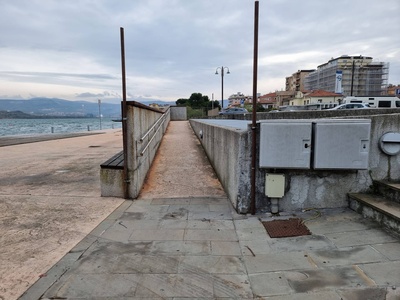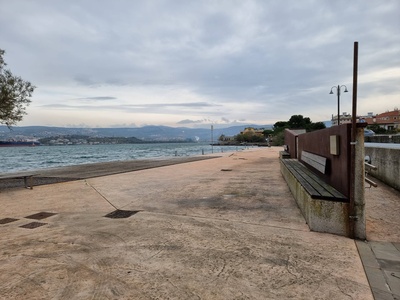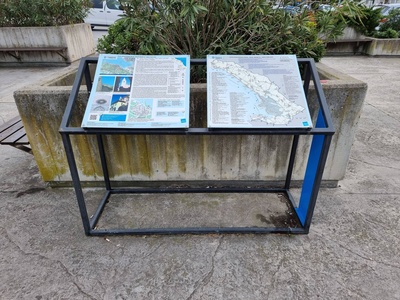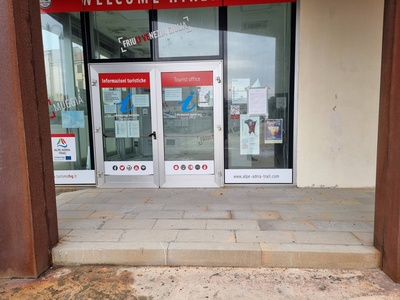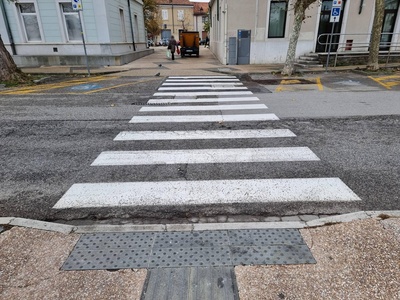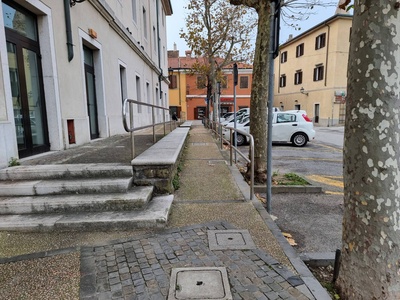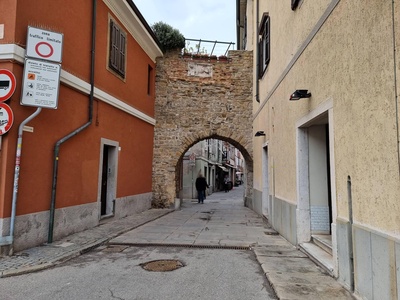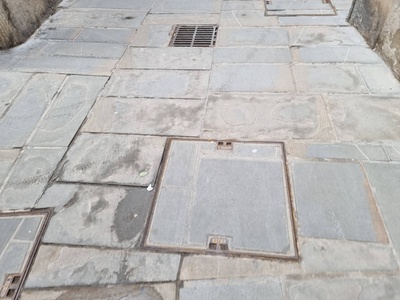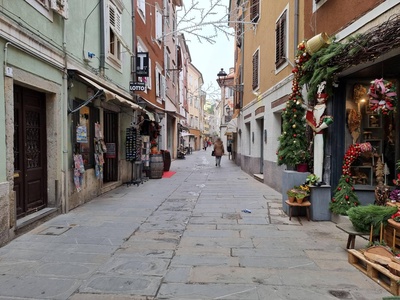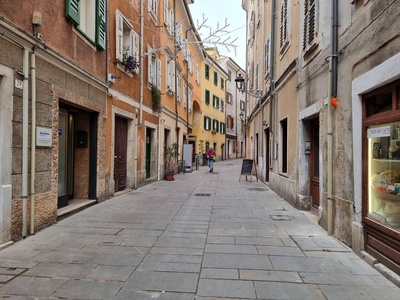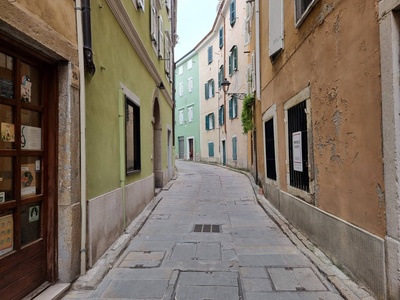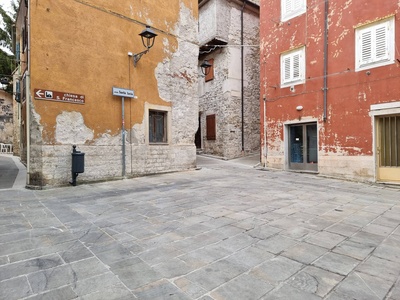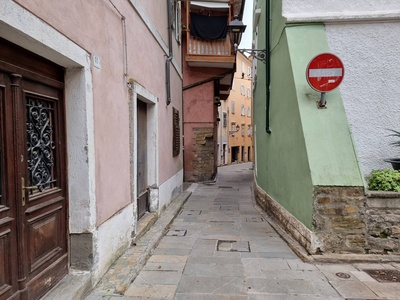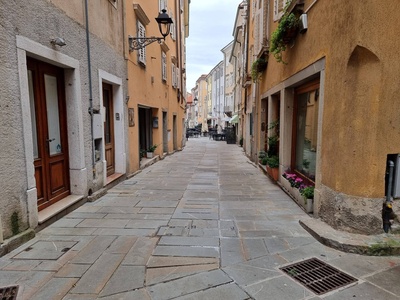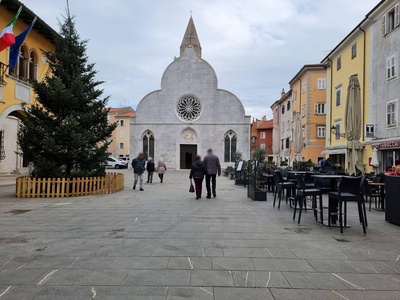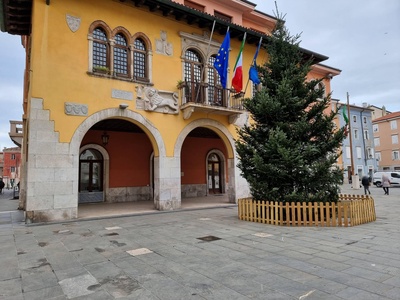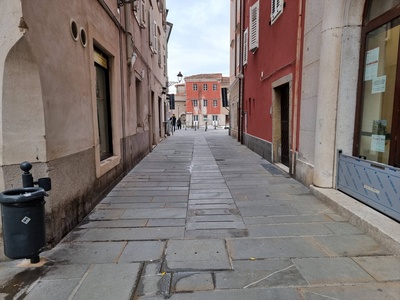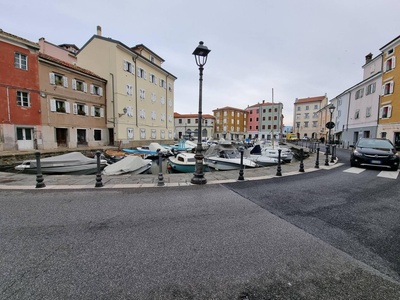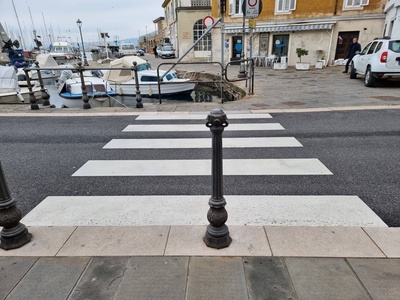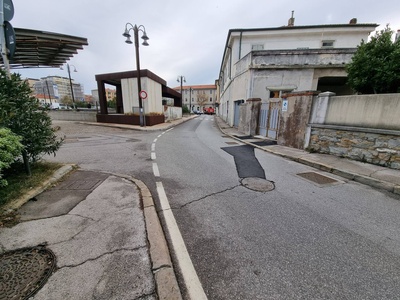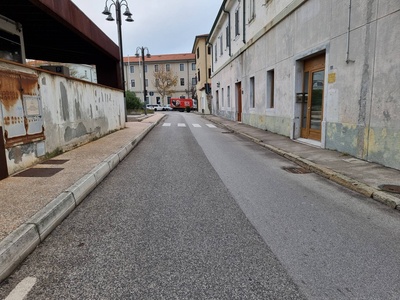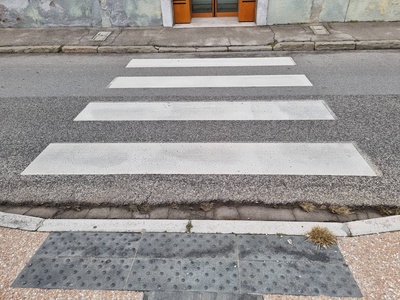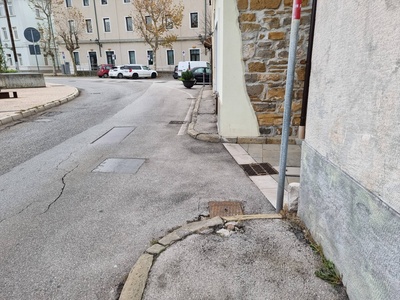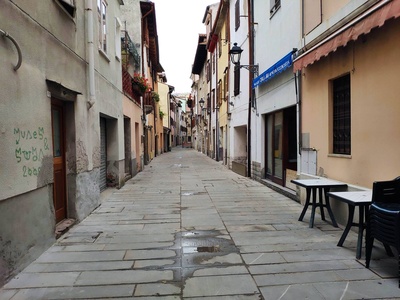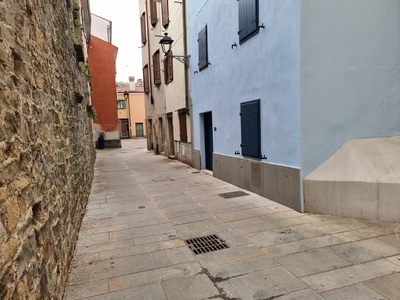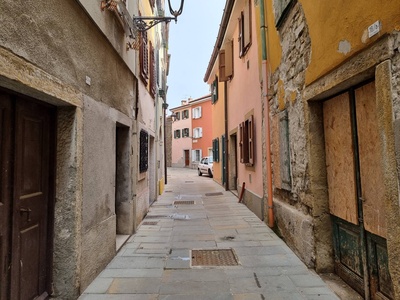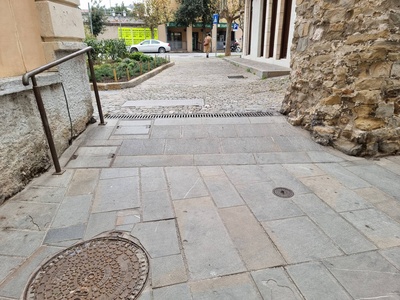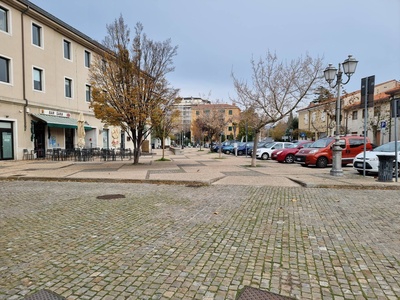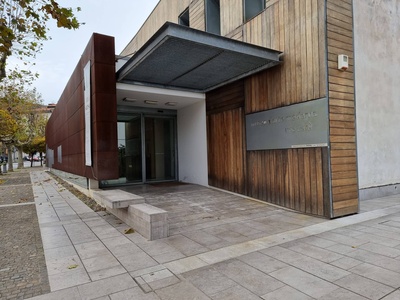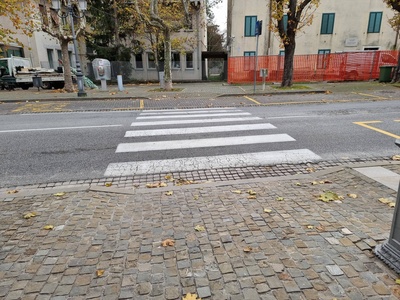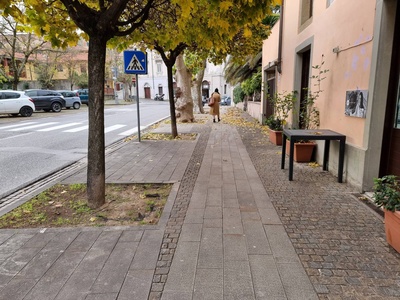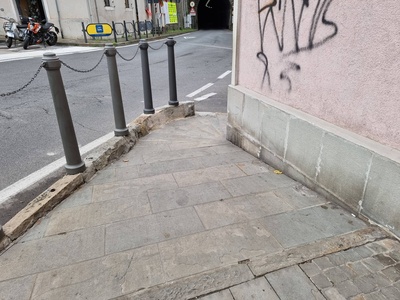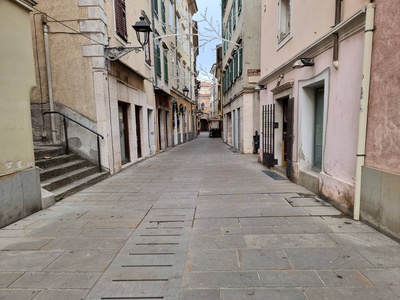Muggia - Tour itinerary

Sea
GENERAL INFORMATION
LAST INSPECTION DATE
29/11/2022
PLANNED ITINERARY
Muggia - Tour Itinerary
LENGTH
1500 meters
DEPARTURE
Caliterna car park - via Battisti
The tour can take place at any time of the year.
The itinerary can be divided into the north and south zones of Muggia. The northern zone is described below. Departure from the Caliterna car park - Via Cesare Battisti. The car park is subject to payment and has approximately seventy parking spaces. There is a parking space reserved for people with disability present, which faces the sea. It has an even and uniform surface made of smooth concrete slabs. There are two additional parking spaces reserved for people with disability in front of Piazza della Repubblica. After leaving the vehicle, it is possible to descend approximately 70 centimetres towards the sea by means of a short flight of 4 steps or with a ramp with a width of 1.3 metres, a length of approximately 20 metres (approximately 9 metres of ramp, 1 metre flat and another 9 metres of ramp) and a slope of approximately 4% (Photographs 1-2). The background is regular and uniform, made of light pink concrete and it features a broad width. This “square“ by the sea has various types of paving: porphyry cubes, stone slabs, concrete slabs, wooden planking, etc. The surface is uniform, although it has some irregularities due to natural ground subsidence. There are some wooden seats (on a concrete base) facing the sea and a wooded area (Photograph 3). The area is also equipped with information signposts (Photograph 4). Towards the sea, there are no protective elements to prevent falling into the sea, and the proximity to the quay is signalled by a change in the paving: there is a transition from concrete slabs to an area of wooden planking and with a zig-zag kerb to a rough-finish concrete (gritstone type).
The Infopoint, temporarily relocated to Piazza Marconi at the Municipality's URP office, is located at the square by the sea (Photograph 5).
Ascending to the level of the car parking area, the itinerary continues by crossing Via Cesare Battisti. The crossing is level, with white stripes on a paved, fairly even surface (Photograph 6). On the side of the car park, there is a wide, (greater than 1.20 metres) and pink-coloured grit pavement. LOGES modules are located at the ramps connecting the pavement (raised 12 centimetres above the road) with the road surface for the pedestrian crossing. Between the kerb of the pavement and the road surface, there is a difference in height of 2 centimetres. On the other side of the street, towards Piazza Repubblica, there is a wide pavement in granular material alternating with bands of porphyry cubes. The pavement is however regular. The road surface is connected to the pavement level by a short connecting ramp and has a difference in height of 2 centimetres between the road and the pavement. To the right of the crossing, there are two parking spaces reserved for people with disability. There are two parking spaces reserved for people with disability at the Theatre. The entrances to the buildings are raised above the pavement level and to reach the same level there is a connecting ramp approximately 11 metres long with a 5% slope (Photograph 7). There is a flat itinerary to the right of the crossing leading to the centre of Muggia, which is also provided with vertical signposts.
Continue along the pavement of Via Cesare Battisti, to the right of the pedestrian crossing towards Via Atessandro Manzoni until reaching the pedestrian area in the centre of Muggia. The pedestrian area is characterised by a first zone in which there are two narrow pavements at the edge of the road ( asphalt) raised about ten centimetres above the road, without a connecting ramp (Photograph 7). An even stone slab pavement is built after the stone arch, with some irregularities created by the conformation of the terrain (Photograph 8). From this point, the itinerary continues straight along Via Dante Alighieri. The entire pedestrian area (Via Dante Alighieri and Calle Verdi) features numerous business venues, most of which are inside historical buildings and are difficult to access for wheelchair users due to the presence of steps at the entrance or some uphill stretches (Photographs 9-10). Several wheelchair-accessible itineraries are signposted with vertical signage with a white background and blue symbols. In Piazza Santa Lucia, turn right and continue the itinerary downwards on Calle Verdi.
The itinerary continues uphill until it reaches Piazza Santa Lucia (Photographs 11-12). Continue turning right and continuing the itinerary on Calle Verdi, downhill with a slope varying from 2% to 5% for stretches of more than 10 metres (Photographs 13-14). The paving is in stone slabs, uniform surface except for the absence of a few joints, and no pavements.
Piazza Marconi (Photographs 15-16) is paved as described previously, with a uniform surface of stone slabs - for pedestrians; it is a large square that houses the Town Hall and the Duomo (Church of Saint John and Saint Paul), as well as various businesses.
From Piazza Marconi continue by turning right towards Corso Puccini (Photograph 17) to reach Riva De Amicis (Photograph 18). The paving of Calle Puccini - a pedestrian area - exhibits the same characteristics as described previously. Riva De Amicis, by contrast, features a pavement of broad width on the right-hand side, while there is a quay on the left-hand side overlooking the sea, the passage of which is possible but with some narrowing because of the presence of poles (Photograph 19). Moreover, as there is no protection towards the sea, safety conditions are generally very low. In both cases, the pavements are at the same level as the road and are therefore protected from the latter by a series of steel posts. The pavements in Via De Amicis are made of stone slabs, with a regular and uniform surface (Photograph 20).
Two pedestrian crossings are located at Corso Puccini and further on towards the square in front of the Municipal fish market (on the left): the surface is paved, regular and uniform surface, and there are no differences in level with the pavement, so the crossing is level. The crossing is marked by white stripes on a paved surface. The pedestrian crossing in the fish market area is level (Photograph 21), the stone-paved pedestrian area is reached, and after approximately ten metres the pavement begins, raised above the road surface and connected by a short ramp.
After a short distance, at the height of Calle Bacchiocco (near Piazza Galilei - which is also a pedestrian area) the pavement on the right-hand side is interrupted (Photograph 22) and it is necessary to cross the road (the pedestrian crossing is located at the Municipal fish market). The pavement on the left-hand side of Via Manzoni (the next street after Riva de Amicis) is approximately 70 centimetres in width (average width due to the shape of the street and the buildings), raised 15 centimetres above street level, and has a fairly regular paved surface, except for the section near the first driveway, where the uneven surface and the high transversal slope make it very difficult for wheelchair users to pass. The surface is stone, level, regular and uniform and directly connected to the adjacent pedestrian area. The pavement on the right-hand side of Via Manzoni is paved, with a fairly regular surface, but it is not completely accessible, as it is 15 centimetres higher than the road surface and not connected to it (except at the height of the Caliterna car park), and has an average width of 60-70 centimetres, starting from the height of the previously described driveway access on the left-hand side. At the height of the bend, the pavement on the right-hand side widens, while on the left-hand side, it is interrupted at the height of the entrance to the Caliterna car park, with a short connecting ramp to the ( asphalt) road surface. There is no pedestrian crossing signposted by stripes and the following pavement has a connecting ramp inside the parking area (after crossing the water drainage channel, a somewhat uneven stone cube surface for about ten metres and having overcome an obstacle due to the presence of a light pole together with a signpost) (Photographs 23-24).
Continuing towards Via Battisti, the pavement on the right side continues with the same characteristics described previously, while the pavement on the left side has a regular and uniform surface in granular material, a width of more than 90 centimetres and is raised above the road surface by an average height of 15 centimetres (Photograph 25). A pedestrian crossing (Photograph 26) is located approximately 20 metres after the bend. It is level, paved with white stripes, connected with short ramps on both sides and signposted by LOGES modules on the left. On the right-hand side, there is a difference in height measuring 3 centimetres, which makes it difficult to climb up to the pavement, while on the left-hand side, there is a difference in height of approximately 2 centimetres with the road surface and the water drainage channel not connected to the road surface, which makes it somewhat difficult to cross. This crossing is necessary because immediately afterwards, on the right-hand side, the pavement breaks at Calle Squero Vecchio, with a difference in height of 15 centimetres. The pavement that follows, which is not connected, has an initial width of 60 centimetres, and the paved surface is particularly disconnected (Photograph 27).
The itinerary continues towards the southern area of Muggia. From Via Cesare Battisti or Piazza della Repubblica, continue to the junction on the left with Calle Ferra Bombizza (Photograph 28). This is a pedestrian area and the paving exhibits the characteristics described previously: uniform surface and regular stone. Shortly afterwards, turn right onto Calle Oberdan (characteristics as described previously) (Photograph 29) and continue to the Museum of Muggia and the Territory. Continue to the junction with Calle Graziadio and here turn left along Calle Giacomo Puccini. This area is also a pedestrian zone and the paving has the same characteristics as described previously.
Immediately afterwards, at the Church, turn left again and take Calle Giuseppe Parini (the pavement described previously, with a constant downhill slope of 3%) (Photographs 30-31) until it reaches Piazza della Repubblica. The final section of Calle Parini towards Piazza della Repubblica presents some critical issues caused by the presence of an uneven porphyry cube base (some cubes missing and soil deformation) and a drainage channel, preceded by a ramp 3 metres in width and 1.50 metres in length, 18% slope (Photograph 32). The corresponding pavement starts with an average height difference of 15 centimetres, then continues on the porphyry cube path until it reaches the pavement of Via Roma.
Piazza della Repubblica (Photographs 33-34) is a large square paved with geometresc patterns in stone and asphalt, with seating and trees. There are some business activities present. Parking spaces for about fifteen vehicles are located at the edge of the square, two of which are reserved for people with disability. The surface is paved and the position of the parking spaces is close to the short access ramp to the square.
The itinerary continues along Via Roma - Provincial Road SP 14 - the pavement on the right-hand side is wide and raised above the road surface by approximately 15 centimetres, paved in stones of two different sizes: slabs and cubes (Photograph 35). The almost central strip of stone slabs measures 1.00 metre, an even, level ground. Trees are facing the street. Continue along Via Roma to the Museum of Modern Art (Photograph 36) and again to the crossroads on the right of Calle Puccini. Atong this section of the itinerary, there are three pedestrian crossings with the same characteristics: level, on an asphalt surface, white stripes, presence of connecting ramps with the pavement level. The only critical point noted is the presence of the rainwater gutter, made of porphyry cubes, which makes it difficult for a wheelchair to pass (Photograph 37). On Via Roma, at the Library, there is a parking space for people with disability.
The final section of Via Roma towards Calle Puccini (Photograph 38) presents a narrowing of the stone pavement combined with the presence of a ramp (in stone slabs) 2 metres long downhill and curved, with a slope of 9%, which then continues for 12 metres with a slope of 3.5% (Photograph 39).
Calle Puccini - a pedestrian area and the final section of this circular itinerary in the south of Muggia - presents the same characteristics as described previously (Photograph 40). To reach the starting point, the route is followed in reverse.
